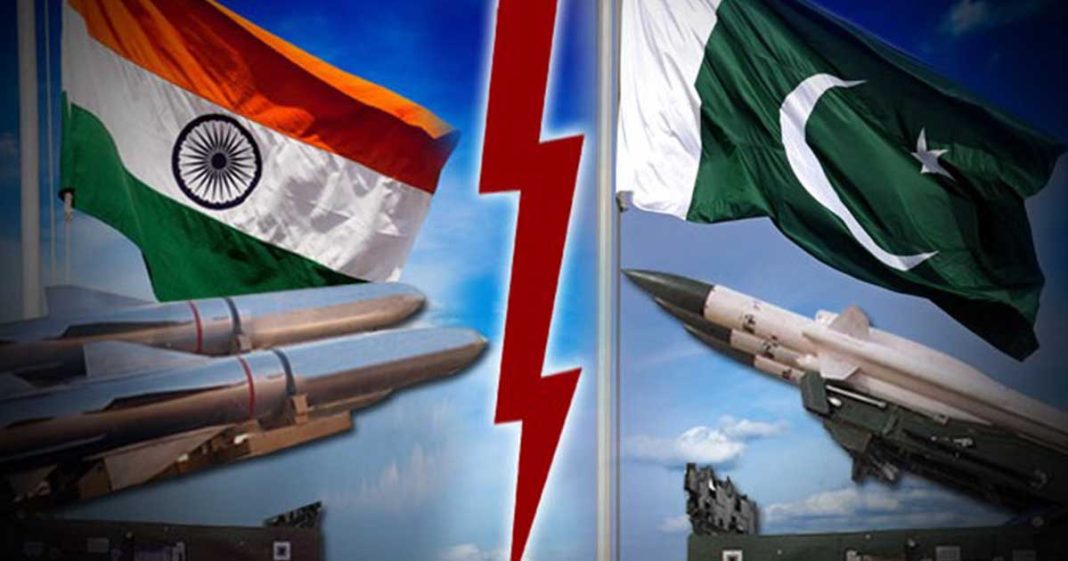
by Rabia Javed 2 September 2022
Ever since independence, the security environment of the South Asian region has remained in a state of flux due to the rivalry between India and Pakistan. Both countries have been involved in numerous border clashes and also fought three major wars. Despite the ambitious plans of India, Pakistan has often proposed India agree to a “strategic restraint regime” to avert the possibility of a total war that could culminate in a nuclear exchange. This can only happen by improving bilateral relations and increased nuclear confidence building measures. To establish such a regime and avoid any nuclear confrontation in the future, India needs to hold back its increasing reliance on nuclear weapons which is undermining the already fragile security situation of the region.
India in its aggressive stature has tried to initiate military offense under nuclear threshold. The predominant asymmetry that exists between both India and Pakistan is one of the major factors that aggravates the acrimony between these powers. Emerging issues such as Hypersonic Glide Vehicles (HGVs), Ballistic Missile Defense systems (BMDs), canisterization of ballistic missiles like the Agni-V, and the nuclearization of the Indian Ocean, have potential to offset deterrence equilibrium in the region. Keeping in mind this growing asymmetry, Pakistan is left with no choice but to increase its reliance on its nuclear capabilities.
The Unbalancing Role of U.S.
The Indo-US relationship is being pursued with one state at the expense of other. India has emerged as a major beneficiary of its cooperation with international players such as U.S. In order to keep a check on global emergence of China and the resurgent Russia, U.S. indirectly helped India which intensified its competition for pre-eminence and hegemony thus further affecting the fragile environment of South Asia. The intensified cooperation and favour dates back to 2005, when the Indo-U.S. Nuclear Deal was signed that further paved the way for India’s Nuclear Supplier Group (NSG) waiver in 2008. After that multiple agreements were signed that favoured India in cementing agreements such as Defence, technology and trade initiative (DTTI), Logistics Exchange Memorandum of Agreement (LEMOA), Communications Cooperation and Security Agreement and Basic Exchange and Cooperation Agreement (BECA). These agreements not only helped India to further its military ambition beyond South Asia but also assisted India to pursue a hostile policy towards its immediate neighbours.
Regional Asymmetries
India and Pakistan have remained locked in perpetual hostility with intricate and dangerous security landscape ever since their independence. Influenced by regional and global factors the rivalry has acquired a complex dimension. The ever-widening trust deficit and nuclear dyad has experienced previous close calls with escalatory potential, from the Kargil conflict in 1999 to the recent missile misfire incident in 2022. Kashmir dispute remains a core issue between India and Pakistan which is also considered as a nuclear flashpoint particularly following the abrogation of Article 370 and 35A of the Indian Constitution by BJP. Interestingly, India’s conventional and nuclear forces are mostly Pakistan specific and do not contribute to its deterrence relationship viz-a-viz China. This imbalance is also a major concern for Pakistan as India has become the third largest military spender of the world as claimed by a report published by SIPRI.
The Indian plan to develop and install BMD systems is another factor that dates back to May 2001, when former U.S. president George W. Bush offered Atal Behari Vajpayee assistance for the acquisition of missile defence. The offer came despite the fact that India was actively involved in the nuclear and missile proliferation to countries such as Iran, Iraq, Libya and North Korea. Though Pakistan has long been an ally of the U.S. in the global war on terror, it was not promised the same assistance — which has increased the country’s security challenges vis-à-vis India. There may be number of reasons for Indian efforts to acquire BMD but most important is its lust for global power status.
Despite all these developments, Pakistan has been open to arms control initiatives, which include building confidence and introducing a strategic restraint regime. It is also evident that the nuclear weapons of Pakistan not only helped in reducing the military asymmetry between India and Pakistan but have also prevented several wars in the region. Hence, acquisition of nuclear weapons by Pakistan worked as an effective nuclear deterrent against India, which has a qualitative and quantitative edge in conventional power. Nuclear weapons have helped reducing major events that could have led to wars in the region, i.e., 1985-86 (Brasstacks), 1990 (Kashmir uprising), 1999 (Kargil conflict), 2001-02 (military stand-off), 2008 (Mumbai attacks) and 2019 (Pulwama attacks).
Lastly, Pakistan’s nuclear weapons programme is a story of national resilience and tremendous sacrifices. The programme is solely for deterrence against India, and to stabilise the fragile strategic balance in the subcontinent. It is widely believed that improving the relationship between Islamabad and New Delhi and stabilising the region is the only way to avoid the rapid growth of the nuclear arms in the region. However, it is the need of the hour that India should seriously consider the long pending strategic restraint regime which will serve the interests of both. Such an agreement will further push regional rivals to improve their overall relations which ultimately translate into a long-lasting strategic stability of the region.
